

Aamsco MISTER Backlit Mirror is LED Illuminated From the Rear on Architecturally Curved Glass
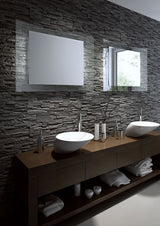
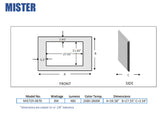
Aamsco MISTER Backlit Mirror is LED Illuminated From the Rear on Architecturally Curved Glass
$1,114.06
$977



Bands of matte glass grace the left and right margins of the architecturally curved glass into which a 27.55" Wide x 21.65" mirror is set. Overall dimensions are 35.58" Wide x 27.55" High x 3.54" Depth, from the rear center to the extremes of the curved glass. Mild LED lighting at 480 Lumens from behind the mirror illuminates the room with a glowing effect The LEDs are rated at 30,000 hours, and have a color temperature of 2,600k - 2,800k, Warm White, with a Color Rendering Index (CRI) of 90+. The mirror conforms to ADA guidelines and is suitable for damp locations such as the bathroom. It is also ETL listed. The mirror consumes only 8 Watts of electricity - truly tiny. This is a hardwired mirror and requires an on-off switch. It is non-dimmable.
Features
- Aamsco's MISTER backlit mirror creats a glowing effect around itself by using LED lighting from the rear creating a halo-effect through and around the architecturally curved glass with it's matte-glass bands, left and right.
- The mirror is suitable for damp locations such as a bathroom. Its 38.58" width is large, yet it's suitable for tandem use over his and hers sinks.
- MISTER is 38.58" Wide x 27.55" High. The viewing area is 27.55" Wide x 21.65" High. Surface mounted, and hardwired, the mirror needs a separate wall switch.
- The mirror consumes only 8 Watts and delivers 480 Lumens - glowing effect - could also be used as a night-light. The LED color temperature is 2,600-2,800 degrees Kelvin, or Warm White with a CRI > 90. Non-dimmable.
- Conforms to ADA guidelines and is ETL listed. 3-Year manufacturer's warranty.
Aamsco
About Aamsco
 Aamsco, since 1975, has been manufacturing innovative lighting solutions for companies, wordwide. In the suburbs of New York City, their original vintage lighting company was formed by Bob Rosenzweig to manufacture antique light bulbs. With Bob's creativity, Aamsco began expanding and moved to New Jersy, and ultimately in 2001 relocated to Summerville, South Carolina where Aamsco continues to grow to this day.
Aamsco, since 1975, has been manufacturing innovative lighting solutions for companies, wordwide. In the suburbs of New York City, their original vintage lighting company was formed by Bob Rosenzweig to manufacture antique light bulbs. With Bob's creativity, Aamsco began expanding and moved to New Jersy, and ultimately in 2001 relocated to Summerville, South Carolina where Aamsco continues to grow to this day.
3,500k vs. 5,500k
Color Temperature Comparison
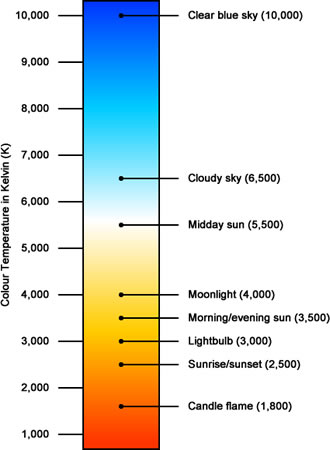
Color Temperature is not Brightness Color temperature describes the color of the light.
The color temperature of any light bulb, including LEDs is measured in degrees Kelvin ("k"). The higher the color temperature, the closer the light is to pure white light at 10,000° K. A blue sky sunny day at noon has a color temperature of about 5,500° K. On a very bright cloud-covered day, the sky registers a color temperature of about 6,500° K., while a "regular" incandescent light bulb has a color temperature of about 2,700° K.
The color temperature of the lighting in your mirror may affect the way people see you in different situations. It's best, therefore, to choose a lighted makeup mirror with a color temperature to approximate your most frequent environment.
Many of our LED mirrors have their color temperature specified. And some makeup mirrors have adjustable or switchable color temperatures. For those where color temperature is not specified a reasonable guide is this: For incandescent bulbs, a color temperature of around 3,000° K. is normal. Fluorescents and LEDs with no color temperature specification have color temperatures around 4,600° K. The chart below can serve as a guide.
The color temperature of any light bulb, including LEDs is measured in degrees Kelvin ("k"). The higher the color temperature, the closer the light is to pure white light at 10,000° K. A blue sky sunny day at noon has a color temperature of about 5,500° K. On a very bright cloud-covered day, the sky registers a color temperature of about 6,500° K., while a "regular" incandescent light bulb has a color temperature of about 2,700° K.
The color temperature of the lighting in your mirror may affect the way people see you in different situations. It's best, therefore, to choose a lighted makeup mirror with a color temperature to approximate your most frequent environment.
Many of our LED mirrors have their color temperature specified. And some makeup mirrors have adjustable or switchable color temperatures. For those where color temperature is not specified a reasonable guide is this: For incandescent bulbs, a color temperature of around 3,000° K. is normal. Fluorescents and LEDs with no color temperature specification have color temperatures around 4,600° K. The chart below can serve as a guide.
If you're planning for an outdoor day, the higher the color temperature the better. For evenings on the town, 2,700&deb; K. to 3,500° K. is best. For office environment lighting conditions, color temperatures around 4,500° K. provide the closest match.
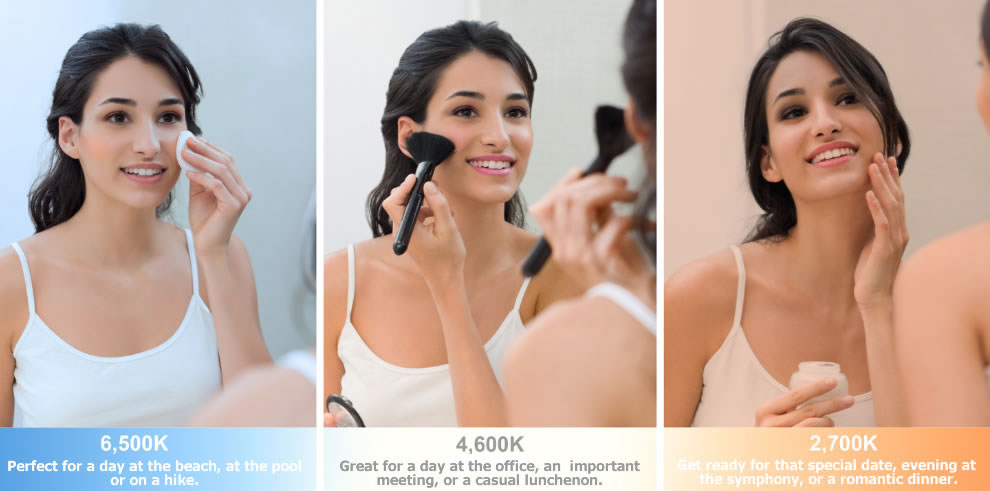
About CRI
Color Rendering Index (CRI)
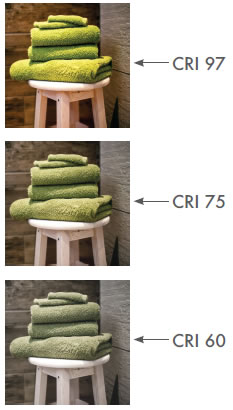
The color rendering index (CRI) is a measure of the ability of a light source to display the colors of various objects faithfully when compared the a natural light source. Light sources with a high CRI value are desirable in color-critical applications such as neonatal care and art restoration. Generally the higher the CRI, the more pleasing to the eye.
The highest possible CRI value is 100 and is frequently achieved by incandescent or "regular" light bulbs. Fluorescent "cool white" bulbs have a CRI of around 50 to 60, but some high-end multi-phosphor fluorescents can go up to 98. LEDs typically have an a CRI around 80, and better, more expensive LEDs can have CRIs up to 97 or 98.
The highest possible CRI value is 100 and is frequently achieved by incandescent or "regular" light bulbs. Fluorescent "cool white" bulbs have a CRI of around 50 to 60, but some high-end multi-phosphor fluorescents can go up to 98. LEDs typically have an a CRI around 80, and better, more expensive LEDs can have CRIs up to 97 or 98.








